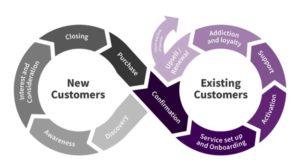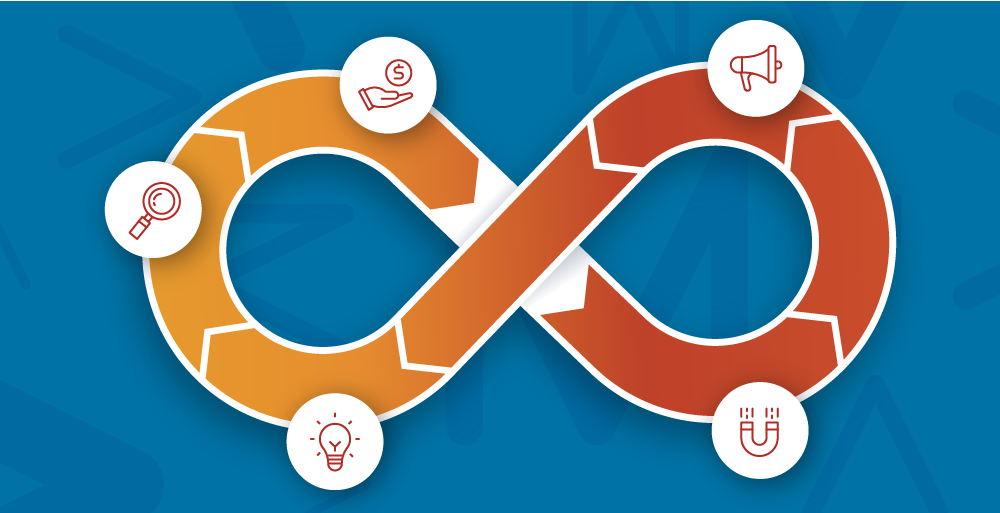Customer journey mapping is a powerful tool for identifying customer touch points and performing a company- wide reality check about the customer experience. Understanding your customer’s journey also will help you design brand experiences that not only convert, but also make the experience with your brand memorable.
For this article I interviewed Kirsti Laasio, a Customer Experience (CX) management executive with a long track record spanning numerous board positions, advisory roles, and speaking engagements. We’ll walk through the basics of customer journey mapping, so you can start building unique brand experiences that turn your customers into raving fans.
What Is Customer Journey Mapping?
According to Laasio, customer journey mapping is an exercise that visually illustrates all the customer interactions with your brand. The customer journey map includes touchpoints where the business has no control, such as social media and third parties.
“Customers leaving can still have touchpoints with your business and they may return one day,” says Laasio, who describes the customer journey as a never-ending loop (see graphic below).

The process of customer journey mapping helps brands:
- Understand the whole customer journey
- Spot issues, fix customer pain points, and reduce friction
- Create memorable brand experiences that convert (and are next to impossible to copy!)
- Become more customer-centric
Creating Unique Brand Experiences That Convert
Marketers’ task is to generate demand, and to do that they need to understand the customer journey.
According to Laasio, customers these days often base their purchase decisions on recommendations. “Customers often gather information from third parties or peers. Therefore the importance of customer reviews and SEO has increased. The first phases of the customer journey are often not visible to the company.”
Laasio notes that the first goal of the customer journey mapping is to identify these initial touch points. She also stresses that the customer journey does not end with the customer acquisition. In fact, the customer journey map takes into account all touch points from the very first contact with the brand to acquisition, repeat purchase, and potential departure. “Let’s not forget that we also need to market to the existing customers, make them happy and keep them coming back. Also departing customers might return one day, therefore let’s make sure they also have a good exit experience.”
Customer journey mapping represents a paradigm shift, where the entire organization changes its outlook from inside-out to outside-in. The process helps the organization understand the end-to-end customer experience and is critical to identifying pain points as well as taking corrective action. The ultimate goal of this optimization process is to create frictionless, delightful, and memorable experiences that touch your customers’ emotions. “Great brands trigger emotions and emotions create strong brand loyalty,” says Kirsti.
Will your customers recommend you further? Laasio believes this is the ultimate test of customer loyalty and the strength of a brand. She points out that customer referrals are essentially “free marketing” and are highly effective. “Earning those peer-to-peer referrals is our ultimate goal next to providing our customers value,” she notes.
Laasio cautions that peer-to-peer marketing can have a downside when customers share bad experiences within their network. In this way, negative brand experience will dilute all your investments, and therefore customer complaints and pain points must always be addressed.
4 Easy Steps to Get Started With Customer Journey Mapping
There are dozens if not hundreds of customer journey mapping tools available, but Laasio recommends getting started with a simple whiteboard and a stack of post it notes.
Customer journey mapping can be divided into four phases:
- Initial mapping out the current customer journey
- Verifying this journey with actual customer(s)
- Drafting “a future state” customer journey map, which illustrates the ideal situation
- Setting up a blueprint for implementation

Customer journey mapping exercise at HappyOrNot, a Finnish customer feedback company.
The first part of the exercise, mapping the current state, can look quite messy in the beginning according to Laasio. “At HappyOrNot we simply used a whiteboard as a canvas and added post it notes, printed screenshots from landing pages, and pictures of automated emails and invoices. We went as far as transcribing sales calls.”
After this initial phase, it is time to invite customers in to verify the draft customer journey map. Often it may happen that what the company imagines is actually quite divorced from reality. Asking customers to verify the customer journey map is a sobering experience that will also turn the process from inside-out to outside-in.

Customers of Prisma, a Finnish hypermarket chain verifying the customer journey map. Image by Henna Ojala.
After the review it is time to generate the desired future-state customer journey map that addresses the customer pain points and areas of improvement. The last phase is developing a final blueprint for implementation.
“[At HappyOrNot] we realized that we were not always delivering what we promised,” said Laasio. “[After the customer journey mapping exercise] we could see how to improve the product life cycle and even create long term plans and product roadmaps.”
Creating a Customer-Centric Organizational Culture
Customer journey mapping process is about a cultural shift. “Everyone in the organization needs to see the customer’s perspective! This is the main point of the whole exercise,” according to Laasio.
She also stresses the importance of treating the customer journey mapping process as a cross-functional exercise, because every team has a role to play in creating a seamless customer experience, not just sales and marketing. Part one of the customer journey mapping could begin with a small map, which can then be filled in by each team. This way the process can become a cross functional exercise that breaks silos and unnecessary hierarchy.
According to Laasio, when staff are empowered to take responsibility for the customer experience and engagement cuts across the organization, it can mark the beginning of the shift to a more customer-centric organizational culture.“Customer journey mapping can be a real game changer through this cultural shift. It is a tool, but also a process.”
To sum up, when customers feel the brand promise is being kept and they are truly being listened to and cared for, they begin to trust your brand. And Laasio concludes this trust, when combined with strong positive emotions, will create brand loyalty: “People do not remember what you said, but they remember how you made them feel.”
Kirsti Laasio
Kirsti Laasio is a Customer Experience Management executive, a board professional, advisor, partner, thought leader and a keynote speaker with extensive international experience in building customer centric brands, leading cross-functional teams, managing SaaS business and product portfolios for both B2B and B2C tech brands.
Contact Kirsti via LinkedIn
Johanna Behm
Johanna is a marketing and localization professional with experience working in four countries across two continents. Johanna has worked in cross-functional teams across multiple industries, including SaaS, internet, cleantech, metaverse, and bioinformatics.
Contact Johanna via LinkedIn





Comments are closed.